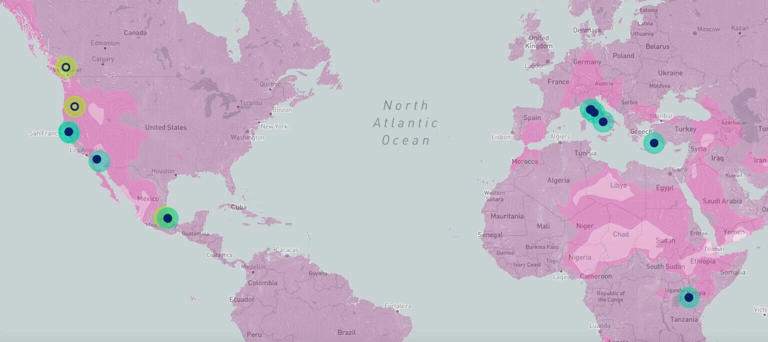Story by Robyn White • 3h • NEWSWEEK

A photo shows the map that pin points where superhot rock geothermal energy may be extracted. It also estimates how much energy could be gained from this source
.© Clean Air Task Force
Scientists have calculated where superhot rock geothermal energy might be extracted, and how much power it might be able to provide.
A map developed by the Clean Air Task Force (CATF) with the University of Twente in the Netherlands pinpoints where we could use this material, and how it could be commercialized.
Superhot rock geothermal is a potential renewable energy source generated from dry rock that's at a temperature of 752 degrees Fahrenheit or more. It can be found all over the planet. According to researchers, there is "vast energy potential" in this material.
"While this modeling is preliminary, our findings suggest an enormous opportunity to unlock vast amounts of clean energy beneath our feet," Terra Rogers, director of Superhot Rock Energy at CATF, said in a statement. "Tapping into just 1% of the world's superhot rock energy potential could generate 63 terawatts of clean firm power, or enough to meet global electricity demand in 2021 nearly eight times over.
"Dozens of wells across the globe have reached superhot conditions, and with the right technical and commercial advances, we could see early commercial-scale plants in years, not decades. Energy security backed by always-available zero-carbon energy isn't a far-off dream—and the people attending events like CERAWeek are uniquely positioned to make that dream a reality."
Scientists have calculated where superhot rock geothermal energy might be extracted, and how much power it might be able to provide.
A map developed by the Clean Air Task Force (CATF) with the University of Twente in the Netherlands pinpoints where we could use this material, and how it could be commercialized.
Superhot rock geothermal is a potential renewable energy source generated from dry rock that's at a temperature of 752 degrees Fahrenheit or more. It can be found all over the planet. According to researchers, there is "vast energy potential" in this material.
"While this modeling is preliminary, our findings suggest an enormous opportunity to unlock vast amounts of clean energy beneath our feet," Terra Rogers, director of Superhot Rock Energy at CATF, said in a statement. "Tapping into just 1% of the world's superhot rock energy potential could generate 63 terawatts of clean firm power, or enough to meet global electricity demand in 2021 nearly eight times over.
"Dozens of wells across the globe have reached superhot conditions, and with the right technical and commercial advances, we could see early commercial-scale plants in years, not decades. Energy security backed by always-available zero-carbon energy isn't a far-off dream—and the people attending events like CERAWeek are uniquely positioned to make that dream a reality."
To gain this energy, researchers would need to use drills to access the superhot conditions deep within the earth. These conditions could then be extracted to provide renewable, carbon-free energy. Using this type of energy would have a smaller land-use footprint than other methods, CATF reports.
Along with its map, the CATF used global heat endowment to estimate "the financial and economic potential that could be unlocked if it were fully commercialized in specific regions, including the U.S."
"Now, it's important for governments and companies to test the extent to which these estimates for superhot rock energy are achievable," Rogers said in the statement.
The most recent research found that just 1 percent of this energy could provide the U.S. with 4.3 terawatts of power. The CATF estimated that this was the same as 21 billion barrels of oil.
They also found that the same amount of superhot rock in Europe could potentially provide 2.1 terawatts of energy.
"Superhot resources are available around the world, with thousands of terawatt-hours on every inhabited continent [i.e., every continent except Antarctica]," a summary of the findings reported. "CATF's preliminary modeling suggests that superhot rock energy at commercial scale would be cost-competitive with current market power prices."
No comments:
Post a Comment